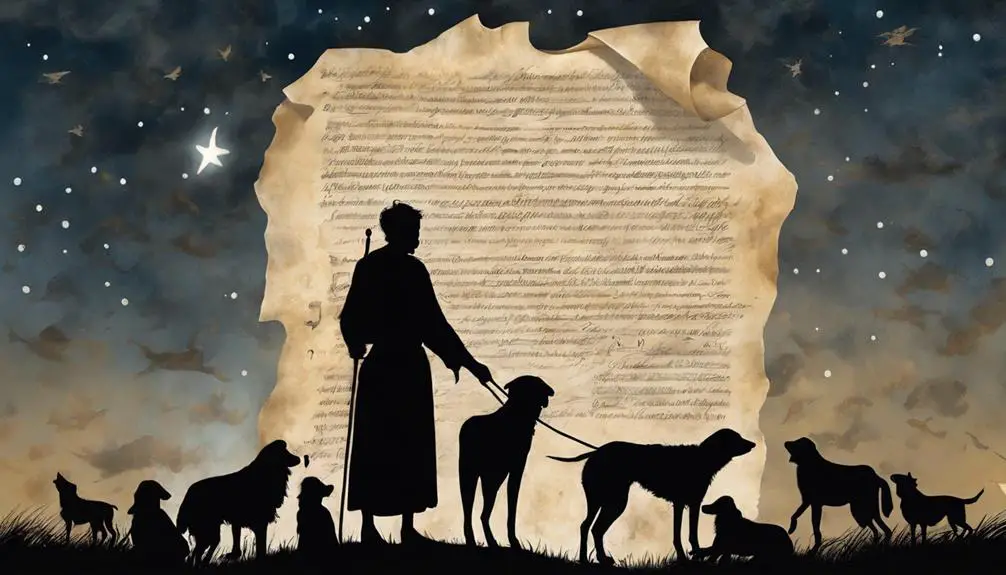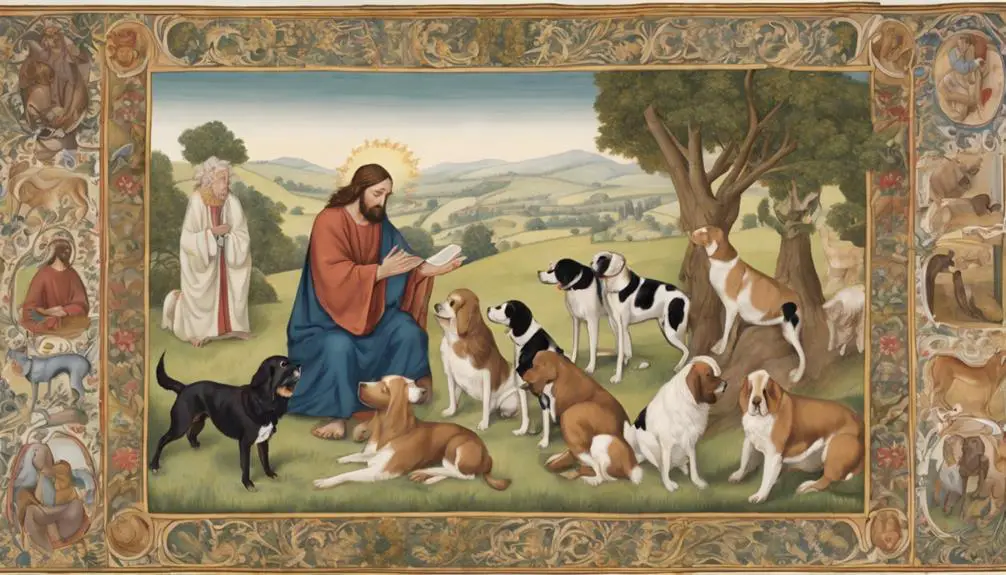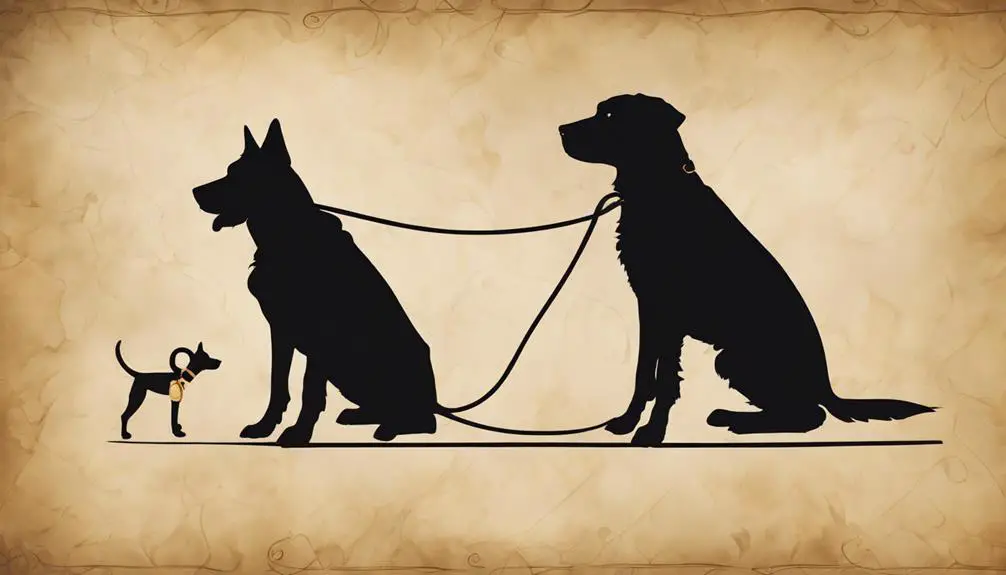Find out about the surprising presence and significance of dogs in biblical texts, a topic rarely explored, yet intriguingly insightful.

Are There Any Bible Verses About Dogs
Imagine the soft rustling of pages as you flip through the time-worn texts of the Bible, seeking references to our four-legged companions, dogs. You've undoubtedly noticed that dogs aren't often the focus in scripture, but did you know they're not entirely absent either?
As you explore these ancient passages, you'll uncover some intriguing mentions of dogs and the roles they played. What might these verses tell us about the cultural and spiritual significance of dogs during biblical times? Let's see if we can unravel this mystery together.
Key Takeaways
- Dogs in the Bible are often symbolized as impure, sinful, or morally compromised individuals.
- Canine imagery in the Bible also portrays loyalty, vigilance, and spiritual truths in parables.
- The Parable of the Rich Man and Lazarus is a notable biblical passage involving dogs.
- Interpretation of dog symbolism in the Bible requires understanding of societal norms and spiritual beliefs.
Dogs in the Old Testament

Delving into the Old Testament, you'll notice that dogs are mentioned in various contexts, each offering unique insights into their roles and symbolism during biblical times. Dogs, as depicted in the Old Testament, often had negative connotations, representing impurity or scavengers. For instance, in 1 Kings 14:11 and 1 Kings 16:4, dogs are described as devouring the deceased, underscoring their scavenger role.
Simultaneously, you'll find dogs associated with disgrace or dishonor. In 2 Samuel 3:8, the term 'dog's head' is used as an expression of deep disdain. Despite these negative associations, it's essential to remember that the Old Testament reflects a specific cultural and historical context.
Interestingly, there's one reference that stands out for its neutrality. In Job 30:1, dogs are simply used to illustrate a point about societal hierarchies. Here, dogs aren't depicted negatively; they're merely a point of reference. So, while dogs in the Old Testament generally carry negative connotations, their representation isn't entirely one-dimensional. It's a nuanced reflection of the broader societal attitudes and norms of that era.
Dogs in the New Testament

Shifting our focus from the Old Testament, let's explore how dogs are portrayed in the New Testament, where their symbolic representation takes on a different nuance. Dogs in the New Testament are typically used to symbolize individuals or groups who are perceived as impure or sinful. This is a significant departure from their Old Testament depiction, underscoring the change in cultural and religious contexts.
Here's an insightful table highlighting some of the key New Testament verses featuring dogs:
Verse |
Context |
Interpretation |
|---|---|---|
Matthew 7:6 |
Jesus' Sermon on the Mount |
Dogs are seen as unholy creatures. |
Philippians 3:2 |
Paul's warning against false teachers |
Dogs are used as a metaphor for deceptive individuals. |
Revelation 22:15 |
Final chapters of the Bible |
Dogs represent those excluded from the heavenly city. |
These depictions of dogs in the New Testament, while not flattering, serve a crucial symbolic function: they represent the societal and spiritual outcasts of the time. This brings a new layer of complexity to the biblical portrayal of dogs, showing their roles in the text extend beyond their physical existence, into the realm of metaphor and symbol.
Notable Dogs in Parables

Turning to parables, you'll find dogs playing pivotal roles, illustrating profound spiritual truths in a relatable, tangible manner. Let's delve into one of the most notable instances, the Parable of the Rich Man and Lazarus.
In this parable, Lazarus, a beggar, desires to eat the crumbs falling from a rich man's table. Dogs are mentioned explicitly, licking Lazarus' sores. Here, dogs serve a dual purpose: they highlight Lazarus' suffering and provide him with some semblance of comfort in his pain. In a sense, these dogs embody compassion, despite their humble status in society.
Examine the character of the rich man in contrast. Despite his wealth, he's devoid of empathy, refusing to share his food with Lazarus. While Lazarus is comforted by dogs, the rich man's wealth isolates him from both human and animal companionship. It's a powerful juxtaposition that underscores the biblical teaching of compassion and charity.
These parables showcase the Bible's nuanced portrayal of dogs. They're not merely passive creatures, but active participants, enhancing the narrative and making the parables more impactful. The dogs in these parables serve as powerful narrative tools, communicating spiritual truths in a unique, memorable way.
Symbolism of Dogs in the Bible

In examining the symbolism of dogs in the Bible, you'll encounter a rich tapestry of meanings, varying across different passages and contexts. It's crucial to understand that the Biblical perspective on dogs is often more nuanced than simplistic interpretations might suggest.
The Bible frequently uses dogs to symbolize unclean or morally compromised individuals. In Deuteronomy 23:18, dogs are metaphorically linked to prostitutes, indicating a connection to impurity and sin. In Revelation 22:15, 'outside are the dogs,' referring to those excluded from heaven, suggesting a symbolic association with wickedness and damnation.
However, the Bible also employs canine imagery to represent qualities like loyalty and vigilance. In the Book of Tobit, a dog accompanies Tobias on his journey, demonstrating loyalty and companionship.
The dog as a symbol in the Bible, therefore, isn't unidimensional but holds diverse implications depending on context. It's a stark reminder that Biblical texts are profoundly layered, asking readers to delve beyond the surface and engage with the complexity of its symbolic language. This careful navigation of symbolism allows for a richer understanding of the Bible's teachings.
Comparing Biblical and Modern View of Dogs

Contrasting the biblical view of dogs with today's perspective can help illuminate the evolution of human-animal relationships over time. In biblical times, dogs were often seen as unclean animals, associated with scavengers, and were not typically kept as household pets. Today, however, dogs are cherished family members, offering companionship and unconditional love.
Consider the following table:
Biblical View |
Modern View |
|---|---|
Unclean, scavengers |
Cherished family members |
Not typically kept as pets |
Commonly kept as pets |
Associated with evil spirits |
Seen as loyal and protective |
Rarely named or individualized |
Often named and deeply loved |
Used in negative metaphors |
Used in positive idioms and expressions |
Through this comparison, you can see the substantial shift in how dogs are perceived. This change is not just in the physical treatment of dogs but extends to the metaphoric and symbolic usage of dogs in language and culture. The analysis of these contrasting views provides a lens through which you can observe the larger societal and cultural shifts over time. So, as you read the Bible, remember to consider the historical context of its references to dogs.
Conclusion
In summary, while the Bible doesn't specifically reference dogs in a domestic sense, they're present in both Old and New Testaments. Parables use dogs to symbolize certain traits, and their symbolism varies.
Comparing biblical and modern views, dogs have shifted from being seen as unclean creatures to cherished companions. Understanding this can deepen our comprehension of biblical texts and how our interpretations evolve with cultural shifts.



Sign up